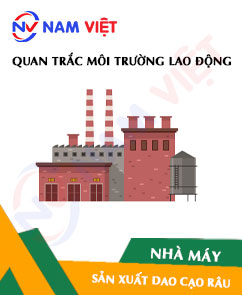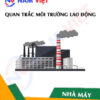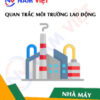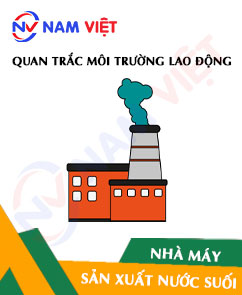Occupational Environment Monitoring at the Razor Manufacturing Factory
99,000 ₫
Note: The above price is calculated for one sample, and the price may fluctuate depending on the area of the environment to be monitored and market movements. For more accurate pricing support, please refer to the pricing table or contact our consulting staff directly.
Environmental monitoring of a razor manufacturing factory is a session of collecting, analyzing, and evaluating workplace factors that may be harmful to workers’ health.
Table of Contents
Toggle1. Overview of Razor Manufacturing Factories
a. What is a razor manufacturing factories?
Manufacturing factory for razors is a facility specialized in the production and assembly of various types of razors. Here, the components and parts of razors are processed, assembled, and inspected to create complete products. This factory can produce a variety of razors, such as electric razors, manual razors, automatic razors, and related accessories.

b. Production stages in a razor manufacturing factory
Production stages in a razor manufacturing factory may include:
- Material preparation: Materials such as stainless steel, plastic, and other components are prepared for use in the production process.
- Component processing: Razor components, including blades, handles, locks, and other parts, are processed from raw materials. The processing may involve cutting, bending, welding, grinding, and plating to produce complete parts.
- Assembly: The processed components are assembled into a complete product. Parts are connected, secured, and quality-checked to ensure effective and safe operation of the razor.
- Inspection and testing: Assembled razors undergo inspection and quality testing. This includes checking blade sharpness, handle hardness and durability, and other factors to ensure the product meets quality standards.
- Packing: After quality inspection, the final product is carefully packed. Packaging may include boxes, moisture-proof and protective bags, labels, user manuals, and accompanying accessories.
- Shipping and distribution: Once packed, products are prepared for shipping to retail points or distributors.

c. Types of machinery used in a razor manufacturing factories
In a razor manufacturing factory, several common machines are used to carry out production stages. Below are some typical machines used in razor production:
- Metal cutting machines: Used to cut and shape razor blades from metal materials such as stainless steel.
- Metal bending machines: Used to bend metal components like razor handles.
- Welding machines: Used to weld metal parts together, such as attaching blades to handles.
- Grinding machines: Used to sharpen blades, ensuring precision and sharpness.
- Plastic processing machines: Used to process plastic components such as locks, caps, and other razor parts.
- Printing machines: Used to print logos, brand names, or other information on the finished product.
- Quality inspection machines: Used to check blade sharpness, handle hardness, and durability of other razor components.
- Packing machines: Used to package the final product in boxes, bags, or other packaging.

d. Occupational diseases that may occur among workers in a razor manufacturing factories
While working in a razor manufacturing factory, workers may be exposed to harmful environmental factors that can cause occupational diseases. Some common occupational diseases in the razor production industry include:
- Diseases related to chemical exposure: Workers may contact chemicals such as solvents, detergents, lubricants, and hardening agents during production. This can cause dermatitis, skin irritation, bleeding, and cracking.
- Diseases related to metal dust and fumes: Metal processing in razor production can generate metal dust and fumes, such as stainless steel. Long-term exposure may cause lung disease, pneumonia, and other respiratory issues.
- Diseases related to vibration exposure: Workers often use vibrating machinery. Prolonged use can cause hand-arm vibration syndrome, affecting dexterity and fine motor tasks.
- Diseases related to light exposure: Some production processes involve strong light, such as laser or UV light. Long-term exposure may cause burns, eye irritation, and vision problems.
- Work-related accidents: While operating machinery and equipment, there is a risk of injury to fingers, hands, wrists, and other body parts.
To ensure safety and protect workers’ health, safety measures and protective equipment such as personal protective equipment, safe work procedures, and regular health checks are necessary in a razor manufacturing factory.

e. Common types of razors on the market
Below are some common types of razors on the market:
- Basic razors: Standard razors with simple cutting blades, usually classic designs for daily shaving.
- Multi-purpose razors: Can be used for shaving, trimming hair, and shaping beards, with interchangeable heads and accessories.
- Electric razors: Powered by electricity, often with strong motors and convenient designs for fast and effective shaving.
- Automatic razors: Operate automatically with sensors and control systems, adjusting to facial contours and beard thickness for precise and gentle shaving.
- Safety razors: Designed to reduce the risk of cuts or skin injuries, featuring guarded blades and automatic depth adjustment mechanisms.
- Single-blade razors: Have only one cutting blade, typically used in professional barber shops requiring precise shaving techniques.
- Electronic razors: Combine electronic technology with shaving, featuring skin sensors, automatic shaving modes, and customizable settings.
2. Overview of Occupational Environment Monitoring Services
a. What is occupational environment monitoring in a razor manufacturing factories?
Occupational environment monitoring (or workplace environment measurement) in a razor manufacturing factory is the activity of collecting, evaluating, and analyzing measurement indicators of occupational environment factors in the factory. The purpose is to implement timely measures to minimize environmental hazards to workers’ health and prevent occupational diseases. Occupational environment monitoring is mandatory for razor manufacturing factories.
Occupational environment monitoring is crucial for caring for, protecting, and enhancing workers’ health because employees are the main resource of a business and directly generate profit. Workers exposed to risks and occupational hazards above permitted limits can suffer health impacts and occupational diseases.
REGISTER FOR OCCUPATIONAL ENVIRONMENT MONITORING SERVICE
b. Nam Viet’s occupational environment monitoring program
Nam Viet’s occupational environment monitoring program is developed by monitoring engineers in labor safety and environmental protection. Aimed at ensuring health and safety for workers, this program uses modern measurement methods to monitor air, water quality, and microclimate, physical, and dust factors in the work environment. It is crucial for maintaining a safe working environment and protecting workers’ health.
Additionally, Nam Viet’s program plays a key role in researching and developing new solutions to improve workplace quality. With the dedication and professionalism of its monitoring experts, Nam Viet’s exclusive program represents a breakthrough in labor safety and environmental management in Vietnam.

c. Standardization in occupational environment measurement procedures
Standardization in Nam Viet’s occupational environment measurement procedures is critical to ensure the quality of results. To guarantee accuracy and reliability, the program follows recognized standards and standardized procedures from the Ho Chi Minh City Department of Health. This ensures that collected data can be reliably used in evaluating the work environment and making decisions to improve it, protecting workers’ health.
These standardized procedures also ensure that measurements are conducted by highly skilled monitoring specialists with years of experience, allowing managers and experts to trust the results from An Toan Nam Viet and make accurate decisions valuable for protecting workers’ health and the environment.
By applying standardization in measurement procedures, Nam Viet demonstrates its commitment to ensuring a safe working environment, protecting workers’ health, and contributing positively to improving labor safety and environmental management in Vietnam.
d. Reporting results of occupational environment monitoring in a razor manufacturing factories
Monitoring results are compiled according to Form 04, Appendix III, issued with Decree 44/2016/ND-CP and is prepared in two copies: one sent to the enterprise that contracted the monitoring service, and one kept at the monitoring organization.
The retention period for occupational environment monitoring results is unlimited according to the law.

e. Frequency of occupational environment monitoring according to legal regulations
According to Clause 2, Article 18 of Labor Safety and Hygiene Law 84/2015/QH13, employers must organize occupational environment monitoring to assess harmful factors at least once a year.
f. Deadline for submitting occupational environment monitoring reports according to legal regulations
The deadline for submission is before December 31 each year. Enterprises must submit occupational environment monitoring reports to the local Department of Health where the enterprise has its main office and where workers are employed.
When there are changes in technology, production processes, or during facility renovation or upgrades that may introduce new harmful factors, enterprises must update labor hygiene records regarding factors requiring occupational environment monitoring.
g. Regulations on penalties for violations of occupational environment monitoring by employers
According to Article 27 of Decree No. 12/2022/ND-CP dated January 17, 2022, on administrative penalties in labor, social insurance, and Vietnamese employees working abroad under contracts:
- Clause 2: Fines from 2,000,000 – 5,000,000 VND for employers who do not publicly disclose to workers at the monitoring site and management locations the results of occupational environment monitoring and hazard evaluation immediately after receiving the results.
- Clause 3: Fines from 20,000,000 – 40,000,000 VND for employers who fail to conduct occupational environment monitoring to control health hazards according to legal regulations.
- Clause 4: Fines from 40,000,000 – 60,000,000 VND for employers who collude with monitoring organizations to commit fraud in occupational environment monitoring activities but not to the extent of criminal liability.
3. Harmful environmental factors for workers in razor manufacturing factories
In razor manufacturing factories, there are several environmental factors that may pose risks to workers. The following are some potential environmental hazards:
- Noise: Factory production activities may generate high noise levels from operating machinery and processing activities. Prolonged exposure to high noise can affect hearing and cause stress and discomfort for workers.
- Dust and chemicals: Razor processing can produce dust and chemicals from cutting and material handling. Dust may irritate the respiratory system and eyes, while chemicals may cause skin irritation and pose long-term hazards.
- Metal exposure: During razor production, workers may come into contact with metals such as stainless steel. Prolonged or improper exposure can lead to cuts, wounds, and risks of heavy metal contamination.
- Temperature and humidity: The working environment may experience fluctuations in temperature and high humidity due to machinery and production processes. Poor environmental conditions can cause discomfort, fatigue, and affect workers’ health.
- Lighting: Insufficient natural light or overly bright artificial light can cause eye strain, reduce concentration, and impact workers’ visual health.
REGISTER FOR OCCUPATIONAL ENVIRONMENTAL MONITORING SERVICE
4. Measures to improve the working environment in razor manufacturing factories
To improve the working environment in razor manufacturing factories and protect workers’ health, the following measures can be implemented:
- Ensure proper ventilation: Install an effective ventilation system to remove dust and chemical vapors from the air. The system should be designed and maintained correctly to ensure good air circulation throughout the factory.
- Implement dust extraction systems: Use dust collection or vacuum systems to remove dust and fine particles during production. This helps reduce workers’ exposure to dust and minimizes respiratory irritation risks.
- Ensure chemical safety: Use safe chemicals and protect employees from direct exposure. Ensure proper use of personal protective equipment such as gloves, masks, and protective clothing to reduce chemical exposure risks.
- Provide appropriate lighting and temperature: Supply adequate natural or artificial lighting in work areas and maintain suitable temperature conditions in the factory. This helps reduce eye strain, improve focus, and prevent adverse effects on workers’ health.
- Training and safety education: Provide training for workers on occupational safety, proper PPE use, and safe work practices. Ensure workers understand potential hazards and know how to prevent and respond to them.
- Regular inspection and maintenance: Periodically inspect and maintain factory equipment, machinery, and systems to ensure efficient and safe operation. Promptly address any issues to prevent accidents and occupational diseases.
- Prioritize safety: Build a safety culture in the factory, encourage workers to suggest improvements, and create a safe and supportive working environment for everyone.
- Periodically conduct occupational environmental monitoring in factories, collect and analyze harmful factors affecting workers, and adjust conditions to reduce hazards and prevent occupational diseases.
5. Benefits of periodic monitoring in razor manufacturing factories
An Toan Nam Viet provides businesses with excellent benefits when using occupational environmental monitoring services according to Decree 44/2016/ND – CP on managing and controlling harmful factors in the working environment affecting employees.
- Businesses can proactively control harmful factors in workshops or factories.
- Receive recommendations on measures to minimize harmful factors and improve workplace quality.
- Indirectly protect human resources, a key factor in business development.
- Reduce the impact of occupational diseases on workers’ health, minimizing future treatment costs.
- Improved worker health leads to better product quality and stable production output.
- Ensure compliance with occupational safety laws, avoiding legal risks.
- Enhance credibility and professionalism in all aspects, elevating the company’s brand.
Nam Viet’s environmental monitoring service is a solution to minimize the impact of occupational diseases, contributing to a clean and high-quality working environment.

6. National occupational environmental monitoring center
Occupational Environmental Monitoring Center of Nam Viet is a professional unit monitoring and measuring the quality of working environments across all provinces and cities in Vietnam. With a team of experienced monitoring specialists, the center uses modern equipment to ensure accuracy and reliability.
In addition to monitoring services, the center assists customers in planning, handling, and tracking occupational environmental issues. With the motto “customer-centered,” the center prioritizes customer satisfaction, meets all customer needs, and is committed to providing the best solutions for businesses.
REGISTER FOR OCCUPATIONAL ENVIRONMENTAL MONITORING SERVICE
With investments in technology, equipment, and human resources, Nam Viet’s monitoring center has become a reputable unit in occupational environmental monitoring in Ho Chi Minh City with the following objectives:
- We always value brand reputation and service quality.
- We provide customers with the best and most suitable solutions possible.
- With a team of experienced Masters and Engineers, we aim to protect the environment and benefit businesses.
- Working with Nam Viet Environmental Monitoring team, companies receive professional service from experts and the best cost advantages.
The occupational environmental monitoring process at Nam Viet includes the following basic steps:
- Before conducting monitoring, our company ensures all equipment is calibrated according to legal regulations.
- Strictly implement occupational environmental monitoring procedures as committed to the Department of Health.
- Accurately report monitoring results to employers.
- If monitoring results indicate unsafe conditions, Nam Viet provides remedial solutions, and the employer implements the following:
- Apply measures to improve working conditions, minimizing harmful factors and preventing occupational diseases.
- Organize health checks to detect occupational and work-related diseases for employees in unsafe environments.
- Provide material compensation for employees according to labor laws.

7. Occupational environmental monitoring service quotation
To help businesses conduct occupational environmental monitoring professionally and effectively, Nam Viet provides customers with a high-quality and reasonably priced service quotation for occupational environmental monitoring.
- Our quotation provides detailed information on the costs of monitoring services, including transportation, measurement, analysis, and reporting. Customers can fully rely on the accuracy and reliability of the reports we provide.
- We commit to offering the most competitive and reasonable prices on the market and are always ready to promptly answer all questions regarding monitoring services professionally.
- With Nam Viet’s quotation, customers can easily choose service packages that suit their needs. We are committed to delivering the highest satisfaction with professional service quality.
No comments yet












Review Occupational Environment Monitoring at the Razor Manufacturing Factory
There are no reviews yet.